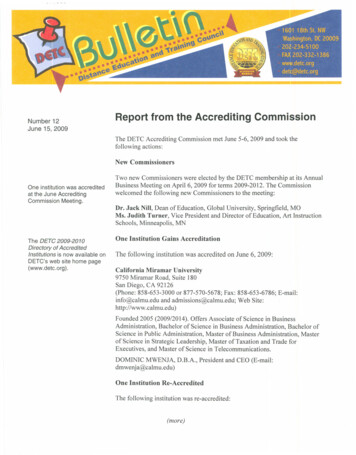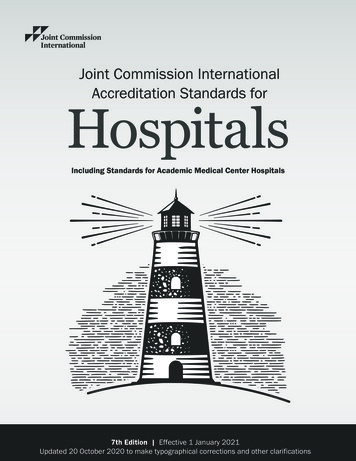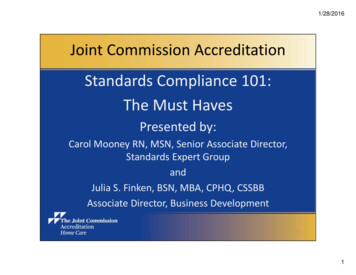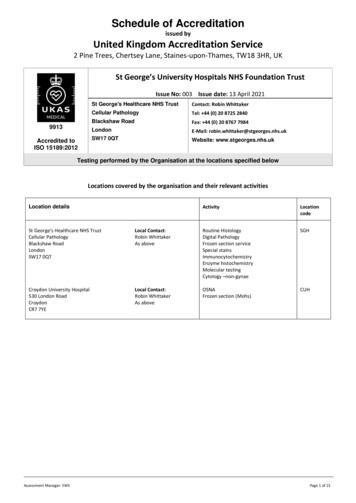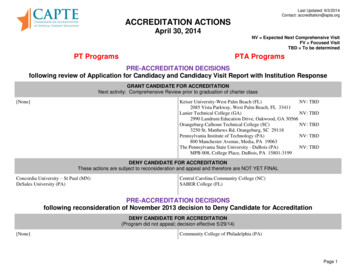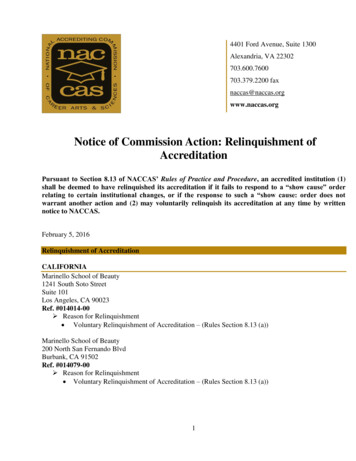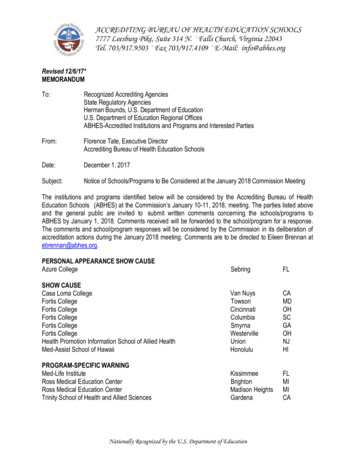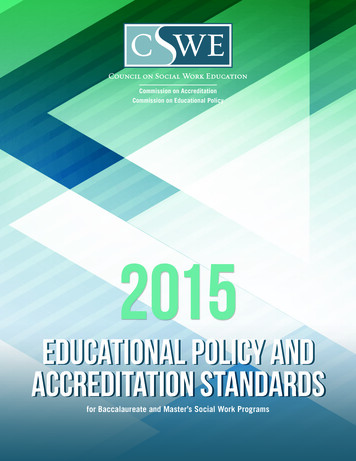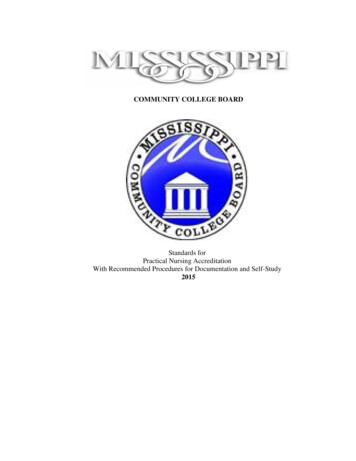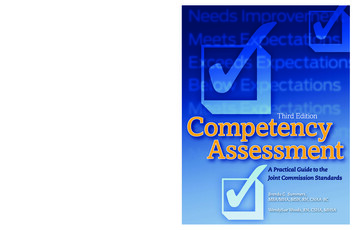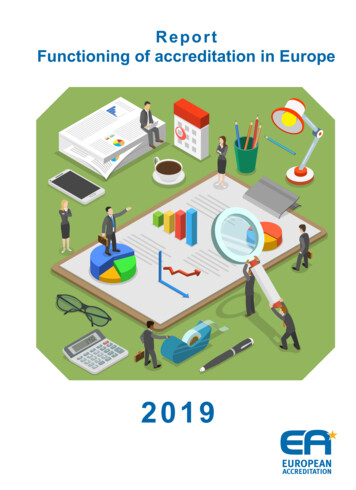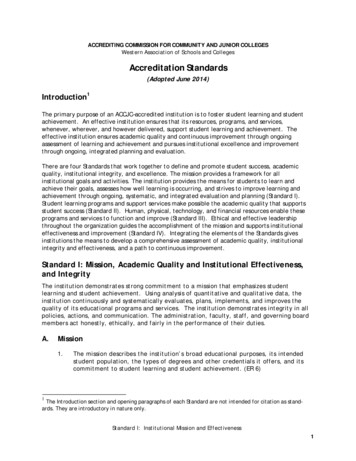
Transcription
ACCREDITING COMMISSION FOR COMMUNITY AND JUNIOR COLLEGESWestern Association of Schools and CollegesAccreditation Standards(Adopted June 2014)Introduction1The primary purpose of an ACCJC–accredited institution is to foster student learning and studentachievement. An effective institution ensures that its resources, programs, and services,whenever, wherever, and however delivered, support student learning and achievement. Theeffective institution ensures academic quality and continuous improvement through ongoingassessment of learning and achievement and pursues institutional excellence and improvementthrough ongoing, integrated planning and evaluation.There are four Standards that work together to define and promote student success, academicquality, institutional integrity, and excellence. The mission provides a framework for allinstitutional goals and activities. The institution provides the means for students to learn andachieve their goals, assesses how well learning is occurring, and strives to improve learning andachievement through ongoing, systematic, and integrated evaluation and planning (Standard I).Student learning programs and support services make possible the academic quality that supportsstudent success (Standard II). Human, physical, technology, and financial resources enable theseprograms and services to function and improve (Standard III). Ethical and effective leadershipthroughout the organization guides the accomplishment of the mission and supports institutionaleffectiveness and improvement (Standard IV). Integrating the elements of the Standards givesinstitutions the means to develop a comprehensive assessment of academic quality, institutionalintegrity and effectiveness, and a path to continuous improvement.Standard I: Mission, Academic Quality and Institutional Effectiveness,and IntegrityThe institution demonstrates strong commitment to a mission that emphasizes studentlearning and student achievement. Using analysis of quantitative and qualitative data, theinstitution continuously and systematically evaluates, plans, implements, and improves thequality of its educational programs and services. The institution demonstrates integrity in allpolicies, actions, and communication. The administration, faculty, staff, and governing boardmembers act honestly, ethically, and fairly in the performance of their duties.A.Mission1.The mission describes the institution’s broad educational purposes, its intendedstudent population, the types of degrees and other credentials it offers, and itscommitment to student learning and student achievement. (ER 6)1The Introduction section and opening paragraphs of each Standard are not intended for citation as standards. They are introductory in nature only.Standard I: Institutional Mission and Effectiveness1
B.2.The institution uses data to determine how effectively it is accomplishing itsmission, and whether the mission directs institutional priorities in meeting theeducational needs of students.3.The institution’s programs and services are aligned with its mission. The missionguides institutional decision-making, planning, and resource allocation and informsinstitutional goals for student learning and achievement.4.The institution articulates its mission in a widely published statement approved bythe governing board. The mission statement is periodically reviewed and updatedas necessary. (ER 6)Assuring Academic Quality and Institutional EffectivenessAcademic Quality1.The institution demonstrates a sustained, substantive and collegial dialog aboutstudent outcomes, student equity, academic quality, institutional effectiveness,and continuous improvement of student learning and achievement.2.The institution defines and assesses student learning outcomes for all instructionalprograms and student and learning support services. (ER 11)3.The institution establishes institution-set standards for student achievement,appropriate to its mission, assesses how well it is achieving them in pursuit ofcontinuous improvement, and publishes this information. (ER 11)4.The institution uses assessment data and organizes its institutional processes tosupport student learning and student achievement.Institutional Effectiveness5.The institution assesses accomplishment of its mission through program review andevaluation of goals and objectives, student learning outcomes, and studentachievement. Quantitative and qualitative data are disaggregated for analysis byprogram type and mode of delivery.6.The institution disaggregates and analyzes learning outcomes and achievement forsubpopulations of students. When the institution identifies performance gaps, itimplements strategies, which may include allocation or reallocation of human,fiscal and other resources, to mitigate those gaps and evaluates the efficacy ofthose strategies.7.The institution regularly evaluates its policies and practices across all areas of theinstitution, including instructional programs, student and learning support services,resource management, and governance processes to assure their effectiveness insupporting academic quality and accomplishment of mission.8.The institution broadly communicates the results of all of its assessment andevaluation activities so that the institution has a shared understanding of itsstrengths and weaknesses and sets appropriate priorities.Standard I: Institutional Mission and Effectiveness2
9.C.The institution engages in continuous, broad based, systematic evaluation andplanning. The institution integrates program review, planning, and resourceallocation into a comprehensive process that leads to accomplishment of itsmission and improvement of institutional effectiveness and academic quality.Institutional planning addresses short- and long-range needs for educationalprograms and services and for human, physical, technology, and financialresources. (ER 19)Institutional Integrity1.The institution assures the clarity, accuracy, and integrity of information providedto students and prospective students, personnel, and all persons or organizationsrelated to its mission statement, learning outcomes, educational programs, andstudent support services. The institution gives accurate information to studentsand the public about its accreditation status with all of its accreditors. (ER 20)2.The institution provides a print or online catalog for students and prospectivestudents with precise, accurate, and current information on all facts,requirements, policies, and procedures listed in the “Catalog Requirements” (seeendnote). (ER 20)3.The institution uses documented assessment of student learning and evaluation ofstudent achievement to communicate matters of academic quality to appropriateconstituencies, including current and prospective students and the public. (ER 19)4.The institution describes its certificates and degrees in terms of their purpose,content, course requirements, and expected learning outcomes.5.The institution regularly reviews institutional policies, procedures, andpublications to assure integrity in all representations of its mission, programs, andservices.6.The institution accurately informs current and prospective students regarding thetotal cost of education, including tuition, fees, and other required expenses,including textbooks, and other instructional materials.7.In order to assure institutional and academic integrity, the institution uses andpublishes governing board policies on academic freedom and responsibility. Thesepolicies make clear the institution’s commitment to the free pursuit anddissemination of knowledge, and its support for an atmosphere in whichintellectual freedom exists for all constituencies, including faculty and students.(ER 13)8.The institution establishes and publishes clear policies and procedures thatpromote honesty, responsibility and academic integrity. These policies apply to allconstituencies and include specifics relative to each, including student behavior,academic honesty and the consequences for dishonesty.9.Faculty distinguish between personal conviction and professionally accepted viewsin a discipline. They present data and information fairly and objectively.Standard I: Institutional Mission and Effectiveness3
10.Institutions that require conformity to specific codes of conduct of staff, faculty,administrators, or students, or that seek to instill specific beliefs or world views,give clear prior notice of such policies, including statements in the catalog and/orappropriate faculty and student handbooks.11.Institutions operating in foreign locations operate in conformity with the Standardsand applicable Commission policies for all students. Institutions must haveauthorization from the Commission to operate in a foreign location.12.The institution agrees to comply with Eligibility Requirements, AccreditationStandards, Commission policies, guidelines, and requirements for public disclosure,institutional reporting, team visits, and prior approval of substantive changes.When directed to act by the Commission, the institution responds to meetrequirements within a time period set by the Commission. It discloses informationrequired by the Commission to carry out its accrediting responsibilities. (ER 21)13. The institution advocates and demonstrates honesty and integrity in itsrelationships with external agencies, including compliance with regulations andstatutes. It describes itself in consistent terms to all of its accrediting agenciesand communicates any changes in its accredited status to the Commission,students, and the public. (ER 21)14.The institution ensures that its commitments to high quality education, studentachievement and student learning are paramount to other objectives such asgenerating financial returns for investors, contributing to a related or parentorganization, or supporting external interests.Standard I: Institutional Mission and Effectiveness4
Standard II: Student Learning Programs and Support ServicesThe institution offers instructional programs, library and learning support services, andstudent support services aligned with its mission. The institution’s programs areconducted at levels of quality and rigor appropriate for higher education. The institutionassesses its educational quality through methods accepted in higher education, makes theresults of its assessments available to the public, and uses the results to improveeducational quality and institutional effectiveness. The institution defines andincorporates into all of its degree programs a substantial component of general educationdesigned to ensure breadth of knowledge and to promote intellectual inquiry. Theprovisions of this standard are broadly applicable to all instructional programs andstudent and learning support services offered in the name of the institution.A.Instructional Programs1.All instructional programs, regardless of location or means of delivery,including distance education and correspondence education, are offered infields of study consistent with the institution’s mission, are appropriate tohigher education, and culminate in student attainment of identified studentlearning outcomes, and achievement of degrees, certificates, employment, ortransfer to other higher education programs. (ER 9 and ER 11)2.(Applicable to institutions with comprehensive reviews scheduled throughFall 2019. 1) Faculty, including full time, part time, and adjunct faculty,ensure that the content and methods of instruction meet generally acceptedacademic and professional standards and expectations. Faculty and othersresponsible act to continuously improve instructional courses, programs anddirectly related services through systematic evaluation to assure currency,improve teaching and learning strategies, and promote student success.(Applicable to institutions with comprehensive reviews scheduled afterFall 2019. 1) Faculty, including full time, part time, and adjunct faculty,regularly engage in ensuring that the content and methods of instruction meetgenerally accepted academic and professional standards and expectations. Inexercising collective ownership over the design and improvement of thelearning experience, faculty conduct systematic and inclusive program review,using student achievement data, in order to continuously improve instructionalcourses and programs, thereby ensuring program currency, improving teachingand learning strategies, and promoting student success.13.The institution identifies and regularly assesses learning outcomes for courses,programs, certificates and degrees using established institutional procedures.The institution has officially approved and current course outlines thatinclude student learning outcomes. In every class section students receive acourse syllabus that includes learning outcomes from the institution’sofficially approved course outline.4.If the institution offers pre-collegiate level curriculum, it distinguishes thatcurriculum from college level curriculum and directly supports students inThe Commission acted to modify the Standard during its January 2018 Board of Directors meeting.Standard II: Student Learning Programs and Services5
learning the knowledge and skills necessary to advance to and succeed incollege level curriculum.5.The institution’s degrees and programs follow practices common to Americanhigher education, including appropriate length, breadth, depth, rigor, coursesequencing, time to completion, and synthesis of learning. The institutionensures that minimum degree requirements are 60 semester credits orequivalent at the associate level, and 120 credits or equivalent at thebaccalaureate level. (ER 12)6.The institution schedules courses in a manner that allows students tocomplete certificate and degree programs within a period of timeconsistent with established expectations in higher education. (ER 9)7.The institution effectively uses delivery modes, teaching methodologiesand learning support services that reflect the diverse and changingneeds of its students, in support of equity in success for all students.8.The institution validates the effectiveness of department-wide course and/orprogram examinations, where used, including direct assessment of priorlearning. The institution ensures that processes are in place to reduce testbias and enhance reliability.9.The institution awards course credit, degrees and certificates based onstudent attainment of learning outcomes. Units of credit awarded areconsistent with institutional policies that reflect generally accepted norms orequivalencies in higher education. If the institution offers courses based onclock hours, it follows Federal standards for clock-to-credit-hour conversions.(ER 10)10.The institution makes available to its students clearly stated transfer-of-creditpolicies in order to facilitate the mobility of students without penalty. Inaccepting transfer credits to fulfill degree requirements, the institutioncertifies that the expected learning outcomes for transferred courses arecomparable to the learning outcomes of its own courses. Where patterns ofstudent enrollment between institutions are identified, the institution developsarticulation agreements as appropriate to its mission. (ER 10)11.The institution includes in all of its programs, student learning outcomes,appropriate to the program level, in communication competency,information competency, quantitative competency, analytic inquiry skills,ethical reasoning, the ability to engage diverse perspectives, and otherprogram-specific learning outcomes.12.The institution requires of all of its degree programs a component of generaleducation based on a carefully considered philosophy for both associate andbaccalaureate degrees that is clearly stated in its catalog. The institution,relying on faculty expertise, determines the appropriateness of each coursefor inclusion in the general education curriculum, based upon student learningoutcomes and competencies appropriate to the degree level. The learningoutcomes include a student’s preparation for and acceptance of responsibleparticipation in civil society, skills for lifelong learning and application ofStandard II: Student Learning Programs and Services6
learning, and a broad comprehension of the development of knowledge,practice, and interpretive approaches in the arts and humanities, thesciences, mathematics, and social sciences. (ER 12)13.All degree programs include focused study in at least one area of inquiry orin an established interdisciplinary core. The identification of specializedcourses in an area of inquiry or interdisciplinary core is based upon studentlearning outcomes and competencies, and include mastery, at theappropriate degree level, of key theories and practices within the field ofstudy.14.Graduates completing career-technical certificates and degrees demonstratetechnical and professional competencies that meet employment standards andother applicable standards and preparation for external licensure andcertification.15. When programs are eliminated or program requirements are significantlychanged, the institution makes appropriate arrangements so that enrolledstudents may complete their education in a timely manner with a minimum ofdisruption.16.B.The institution regularly evaluates and improves the quality and currency of allinstructional programs offered in the name of the institution, includingcollegiate, pre-collegiate, career-technical, and continuing and communityeducation courses and programs, regardless of delivery mode or location. Theinstitution systematically strives to improve programs and courses to enhancelearning outcomes and achievement for students.Library and Learning Support Services1.The institution supports student learning and achievement by providing library,and other learning support services to students and to personnel responsiblefor student learning and support. These services are sufficient in quantity,currency, depth, and variety to support educational programs, regardless oflocation or means of delivery, including distance education andcorrespondence education. Learning support services include, but are notlimited to, library collections, tutoring, learning centers, computerlaboratories, learning technology, and ongoing instruction for users of libraryand other learning support services. (ER 17)2.Relying on appropriate expertise of faculty, including librarians, and otherlearning support services professionals, the institution selects and maintainseducational equipment and materials to support student learning and enhancethe achievement of the mission.3.The institution evaluates library and other learning support services to assuretheir adequacy in meeting identified student needs. Evaluation of theseservices includes evidence that they contribute to the attainment of studentlearning outcomes. The institution uses the results of these evaluations as thebasis for improvement.4.When the institution relies on or collaborates with other institutions or otherStandard II: Student Learning Programs and Services7
sources for library and other learning support services for its instructionalprograms, it documents that formal agreements exist and that such resourcesand services are adequate for the institution’s intended purposes, are easilyaccessible and utilized. The institution takes responsibility for and assuresthe security, maintenance, and reliability of services provided either directlyor through contractual arrangement. The institution regularly evaluates theseservices to ensure their effectiveness. (ER 17)C. Student Support Services1.The institution regularly evaluates the quality of student support services anddemonstrates that these services, regardless of location or means of delivery,including distance education and correspondence education, support studentlearning, and enhance accomplishment of the mission of the institution. (ER 15)2.The institution identifies and assesses learning sup
Accreditation Standards (Adopted June 2014) Introduction1. The primary purpose of an ACCJC–accredited institution is to foster student learning and student achievement. An effectiveinstitution ensures that its resources, programs, and services, whenever, wherever, and however
